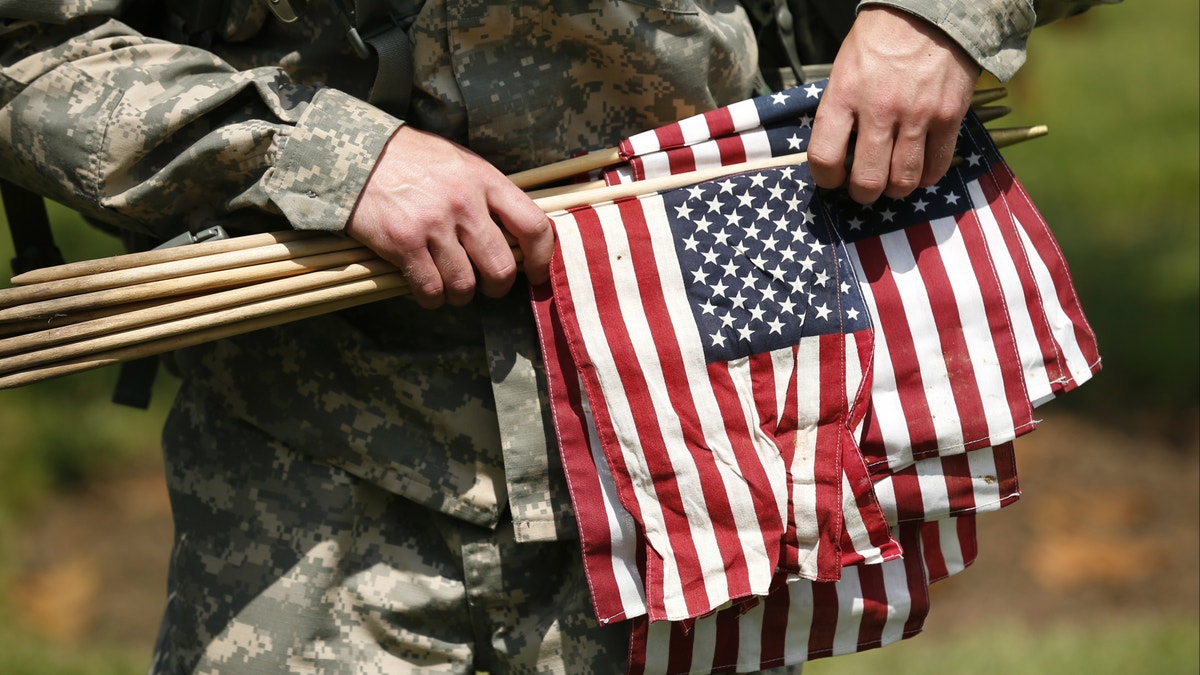
A member of the Third U.S. Infantry Regiment (The Old Guard) carries flags during a "Flags-In" ceremony at Arlington National Cemetery in Washington. (REUTERS/Kevin Lamarque)
It is Memorial Day 2015. In cemeteries across the country flags flutter, flowers grace the graves of the departed, and bugles sound the mournful notes of Taps. The crowds paying tribute, however, have grown sparse.
Begun as a way to honor Civil War dead, the commemoration was long called Decoration Day from the practice of decorating graves. The observance was held on May 30 no matter the day of the week. Since 1971, Memorial Day has been observed on the last Monday in May as the end of a federally mandated three-day weekend. Now firmly ingrained as the traditional start of the summer season, the solemn reasons behind the day have faded despite the continuing sacrifices of so many.
Seventy years ago, it was very different. Memorial Day 1945 marked an uneasy time of mixed emotions. There was celebration, remembrance, and dread. World War II in Europe was over by three weeks and no more battle casualties would join the rows of crosses planted from North Africa to the beaches of Normandy and across France into Germany. But the war in the Pacific still raged. Many Americans who had fought in Europe feared they would be going to the other side of the globe to continue the fight against Japan rather than back to the States for a victorious homecoming.
On this Memorial Day, we honor the sacrifices of prior generations. We honor the sacrifices of the men and women next door who have served or continue to serve our country. And we pledge never to forget the true meaning of Memorial Day.
In the far Pacific, forces led by Admiral Chester W. Nimitz battled to wrap up the invasion of Okinawa, a long and bloody struggle that cost the lives of more than 12,000 American soldiers, sailors, and marines, including U.S. Tenth Army commander Simon Bolivar Buckner. In the southwest Pacific, having fulfilled his promise to return to the Philippines, General Douglas MacArthur sought to complete his occupation of the islands and plan the final assault against Japan.
In the Pacific that year, Memorial Day observances were particularly solemn. Fresh graves were decorated in cemeteries with names largely unknown a year earlier: Saipan, Peleliu, Leyte, Iwo Jima, and Okinawa. The question that could not yet be answered was how many more graves and cemeteries would be required to end the war. On Saipan, a special service was held for crews of B-29 bombers lost in the air war against Japan’s home islands. Their final resting places were unknown.
In the United States, Eleanor Roosevelt intended to pay a quiet visit to her husband Franklin’s fresh grave at Hyde Park, but found instead an overflowing crowd of well-wishers. Among the tributes to the fallen leader was a wreath sent by the current president, Harry Truman. It was laid on Roosevelt’s grave to honor the man who had led America longer than any other president and died within sight of victory.
Truman also sent a message to a “Salute to the GI’s of the United Nations” rally in Madison Square Garden. The new president emphasized the four essential human freedoms long articulated by Roosevelt: freedom of speech, freedom of religion, freedom from want, and freedom from fear. The American Secretary of State and the Soviet Ambassador to the United States were in attendance. Each praised American-Soviet cooperation in the war and expressed hopes for a long-lasting peace.
In Chicago, an estimated 750,000 citizens turned out to cheer General Mark W. Clark, a veteran of the long, frustrating Italian campaign. Clark had made a surprise flight from Paris to Chicago to lead a parade down State Street to observances at Grant Park. Clark expected to receive orders momentarily to report to the Pacific.
On the West Coast, ports and shipyards continued to fill supply lines with men and materiel in anticipation of bitter and costly invasions to come. Yet, there was also the anticipation of hordes of returning servicemen. Newspapers warned veterans to be wary of scams that purported to offer college benefits.
In the tiny hamlet of Airmount west of New York City, Jesse Tompkins was one of the few Civil War veterans still living. Two weeks shy of 98, he spent the day at his home reading newspapers and listening to the radio. Quoted as saying he had seen enough parades, Tompkins would not live to see Japan’s surrender. Mercifully for all, it came later that summer.
On that Memorial Day seventy years ago—a day one newspaper called “a day of dedication”—there was indeed hope that battlefields would become relics of the past. Such has not been the case. No one foresaw then the places American soldiers, sailors, marines, and airmen, as well as coast guard personnel, firefighters, and law enforcement officers, would be required to make a stand. To the World War II names would be added Chosin Reservoir in Korea, Khe Sanh and Pleiku in Vietnam, Kirkuk in Iraq, the Korangal Valley of Afghanistan, the World Trade Center, and a thousand others at home and around the world.
On this Memorial Day, we honor the sacrifices of prior generations. We honor the sacrifices of the men and women next door who have served or continue to serve our country. And we pledge never to forget the true meaning of Memorial Day. We would not have the privilege of celebrating this day and honoring so many memories without the sacrifices of those who gave their last full measure of devotion.




















